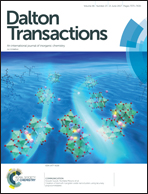Electrocatalytic proton reduction by a model for [NiFeSe] hydrogenases†
Abstract
Two new heterodinuclear nickel–iron complexes [Ni(pbSmSe)FeCpCO]PF6 and [Ni(xbSmSe)FeCpCO]PF6 were synthesized as mimics of the [NiFeSe] hydrogenase active site (HCp = cyclopentadiene; H2pbSmSe = 1,9-diselenol-3,7-dithia-2,2,8,8-tetramethylnonane; H2xbSmSe = 1,2,-bis(2-thiabutyl-3,3-dimethyl-4-selenol)benzene). The compounds were characterized by single crystal X-ray diffraction and cyclic voltammetry. X-ray structure determinations showed that in both NiFe complexes the nickel(II) center is in a square-planar S2Se2 environment; the two selenolate donors are bridging to the iron(II) center that is further coordinated to an η5-cyclopentadienyl group and a carbon monoxide ligand. Electrochemical studies showed that the complex [Ni(pbSmSe)FeCpCO]PF6 is an electrocatalyst for the production of H2 in DMF in the presence of acetic acid at −2.1 V vs. Fc+/Fc; a foot-of-the-wave (FOWA) analysis of the catalytic currents yielded an estimation of kobs of 24 s−1.
![Graphical abstract: Electrocatalytic proton reduction by a model for [NiFeSe] hydrogenases](/en/Image/Get?imageInfo.ImageType=GA&imageInfo.ImageIdentifier.ManuscriptID=C7DT00972K&imageInfo.ImageIdentifier.Year=2017)


 Please wait while we load your content...
Please wait while we load your content...